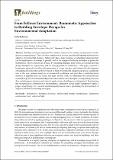Form follows environment: biomimetic approaches to building envelope design for environmental adaptation
Author(s)
Badarnah, Lidia
Downloadbuildings-07-00040.pdf (6.409Mb)
Terms of use
Metadata
Show full item recordAbstract
Building envelopes represent the interface between the outdoor environment and the indoor occupied spaces. They are often considered as barriers and shields, limiting solutions that adapt to environmental changes. Nature provides a large database of adaptation strategies that can be implemented in design in general, and in the design of building envelopes in particular. Biomimetics, where solutions are obtained by emulating strategies from nature, is a rapidly growing design discipline in engineering, and an emerging field in architecture. This paper presents a biomimetic approach to facilitate the generation of design concepts, and enhance the development of building envelopes that are better suited to their environments. Morphology plays a significant role in the way systems adapt to environmental conditions, and provides a multi-functional interface to regulate heat, air, water, and light. In this work, we emphasize the functional role of morphology for environmental adaptation, where distinct morphologies, corresponding processes, their underlying mechanisms, and potential applications to buildings are distinguished. Emphasizing this morphological contribution to environmental adaptation would enable designers to apply a proper morphology for a desired environmental process, hence promoting the development of adaptive solutions for building envelopes. ©2017 Keywords: biomimetics; building envelope; architectural design; morphology; adaptation
Date issued
2017-05-12Department
Massachusetts Institute of Technology. School of Architecture and PlanningJournal
Buildings
Publisher
Multidisciplinary Digital Publishing Institute
Citation
Badarnah, Lidia, "Form follows environment: biomimetic approaches to building envelope design for environmental adaptation." Buildings 7, 2 (May 2017): no. 40 doi 10.3390/buildings7020040 ©2017 Author(s)
Version: Final published version
ISSN
2075-5309